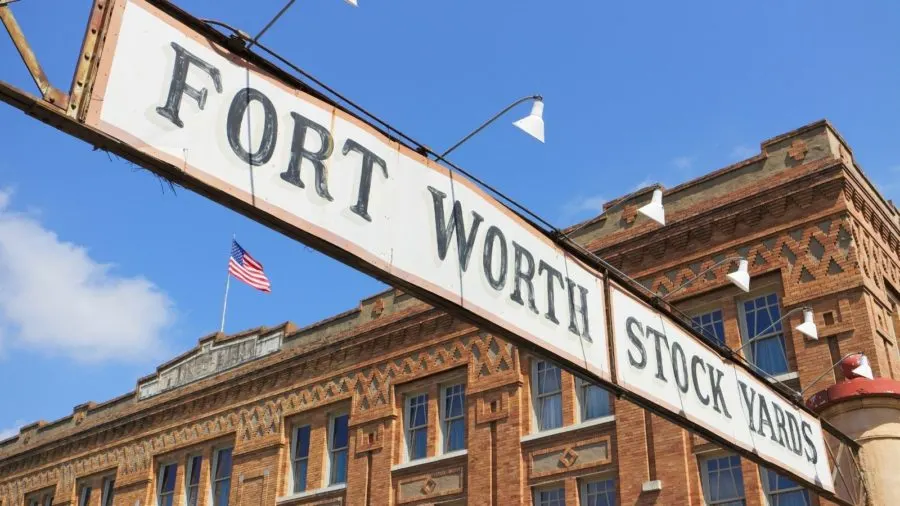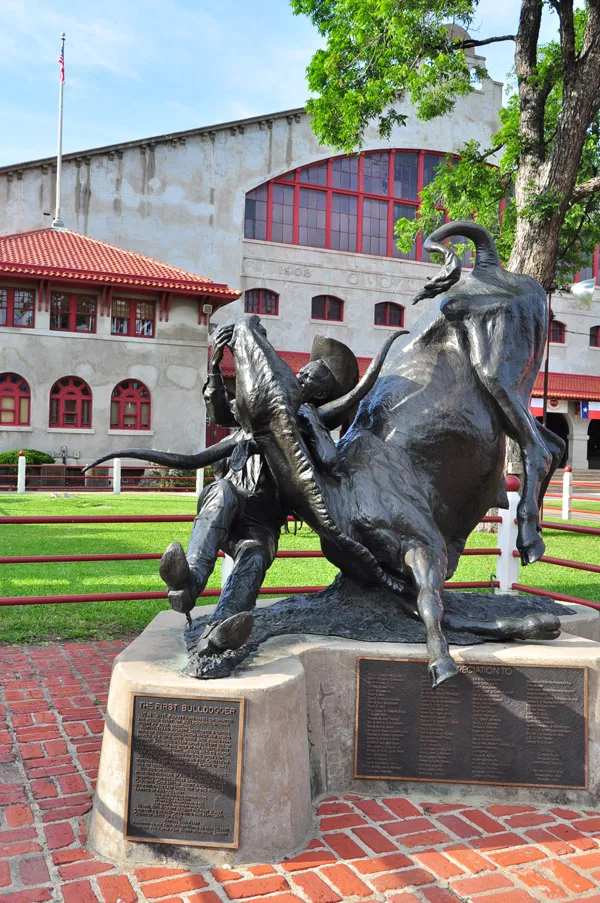If there’s one big city in Texas that has “the look” that many out of state visitors expect to see, it’s probably Fort Worth. This city that calls itself “the place where the West begins” is home to the Fort Worth Stockyards, a National Historic District that’s still home to cowboys on horseback, as well as historic hotels, western shopping, and an all-around good time.
About 30 miles west of Dallas, the city of Fort Worth manages to retain the flavor of its Wild West past while burgeoning as a modern city.
The former rip-roaring cowboy town, known for its gunfights and cattle drives, has preserved its roots both institutionally, through the maintenance of the historic Stockyards, and culturally, through the down-to-earth approach to life that still permeates the city.
But Fort Worth is no backwater; its cultural establishment is the envy of many larger cities, including Dallas. Some may sneeringly dismiss it as “Cowtown,” but in many respects the city provides the best of what both tradition and progress have to offer.
Table of Contents
Fort Worth Stockyards

Just over two miles north of downtown stands the Stockyards National Historic District, once the second largest stockyard in the country with cattle pens that extended nearly one mile. Today the area is a favorite tourist stop with Western shopping, a twice-daily cattle drive, rodeos, and dining.
Twice a day, at 11:30 a.m. and 4 p.m., you can experience the Fort Worth Herd, the world’s only daily cattle drive.
Cowboys drive the cattle along the streets of the Stockyards, a must-see event if you feel your dog won’t be frightened by the sight of Longhorn cattle coming down the street.
Any time you visit, expect to see plenty of people in Western gear. You can also rent a GPS guided tour; the tours will take you by the Cattlemen’s catwalk for a view of the cattle pens, the Cowtown Coliseum that’s home to the world’s first indoor rodeo, Mule Alley which was once called the world’s finest stables, and Billy Bob’s Texas, still holding the record as the world’s biggest honky tonk.
You’ll find parking across from Cowtown Coliseum in Mule Alley, on the east end of Exchange Avenue at Stockyards Station, and one block north of Cowtown Coliseum at Billy Bob’s Texas.

Here a symbol of the Stockyards (and of Fort Worth) is the Livestock Exchange Building (131 East Exchange Ave), constructed in 1902 and for decades used as offices of the stockyards (the Swift and Armour plants once covered acres here, shipping beef around the country.)
Today the Spanish-style building is used for offices and is also home to the small Stockyards Museum, tracing the history of the district.
Wander among the historic streets of the district, making a stop at the Stockyards Hotel, celebrating nearly a century in Fort Worth and boasting a Western atmosphere.
Visit Joe T’s
Saddle up—literally—on a hotel barstool topped with a saddle or mosey over to the city’s best known Mexican restaurant, Joe T. Garcia’s (known to locals as Joe T’s), located just a few blocks away and known for its frosty margaritas and enchiladas. (2201 N. Commerce).
Sundance Square
Fort Worth is best known for its “Cowtown” image, bringing its Old West heritage to life for visitors not only at the Stockyards National Historic Center District but also at the downtown Sundance Square. This a 20-block area is named for the famous Western bandit the Sundance Kid who, along with partner Butch Cassidy, spent time in the area.
Sundance Square holds another local treasure: the Sid Richardson Collection of Western Art, showing Frederic Remington and Charles Russell as well as pieces by several other Western artists.

You can’t miss the Jett Building, constructed in 1907; the building boasts an enormous Chisholm Trail Mural by Richard portraying the Fort Worth stretch of the Chisholm Trail cattle drives.
Sundance Square is also home to one of the city’s architectural gems, the Nancy Lee and Perry R. Bass Performance Hall. Completed in 1998 and designed by David M.Schwarz, the massive concert hall encompasses an entire city block. At the entrance to the hall, you’ll see two 48-foot-tall limestone angels sculpted by Marton Varo; the artwork has become a symbol of the region’s growing cultural offerings.
Check Out an Art Museum
Despite its “aw, shucks” image, Fort Worth also has an enviable collection of cultural venues for a city its size. The Cultural District, located just off the Trinity River, is home to many of the city’s museums and gardens.
The district houses five top museums including the Kimbell Art Museum, often called “America’s best small museum.” The museum is known not only for its survey collection but also for its modern building. Along with top names like Caravaggio, Rembrandt, and Picasso, you’ll find one of the largest collections of Asian art in the Southwest here.the Amon Carter Museum and its collection of American art, and the Modern Art Museum of Fort Worth.
Next, check out the collection at the Amon Carter Museum, founded by Fort Worth publisher Amon G. Carter for his collection of Frederic Remington and Charles M. Russell paintings and sculptures.
Today the museum has grown to almost 240,000 objects focusing on many types of 19th and 20th century American art.
Two rooms are devoted to Russell and Remingston; other collection areas include works by Winslow Homer, Eliot Porter, and Thomas Eakins as well as a strong collection on American photography, started when Dorothea Lange offered the museum her studies of Charles M. Russell.
Don’t miss the Modern Art Museum of Fort Worth, the oldest art museum in Texas. Founded in 1892, the houses a collection of works by Picasso, Pollock, Lichtenstein, and others. At the museum, grab some lunch at Café Modern, known for its seasonal menu with dishes like jerk pork tenderloin and King Ranch chicken casserole.
Before you leave the Cultural District, save time to visit the area’s art galleries. Both Texas artists and nationally known names are represented at William Campbell Contemporary Art (4935 Byers Avenue) or visit the Galerie Kornye West (1601 Clover Lane), specializing in 19th and 20th century fine art.
Take a Walk on the Wild Side
Don’t miss the expansive Fort Worth Botanic Gardens with its peaceful Japanese Garden, and the Fort Worth Zoo, housing both Texas and exotic species.
Make Plans for the Fort Worth Stock Show and Rodeo
Just about any weekend, Fort Worth is celebrating with a festival but some are so well established they hold positions as attractions themselves.
The year always kicks off with the Fort Worth Stock Show and Rodeo; the country’s oldest livestock show also includes musical performances and draws about one million visitors a year.
Shop for Western Wear
Western shopping is the name of the game in downtown Fort Worth, home to Fincher’s White Front Western Wear (115 E. Exchange Ave. in the Stockyards).
Since 1902, this shop has outfitted cowboys with everything from hats to belt buckles. Also in the Stockyards, you can take home boots—or even a saddle—over at ML Boots and Saddlery (2455 N. Main St.).
Boots range from ostrich to stingray and are accompanied by western wear that designed for everything from cocktail parties to calf roping.
Scoot Those Boots at Billy Bob’s Texas
Over on the western side of the Metroplex, Billy Bob’s Texas is a 127,000-square-foot Fort Worth wonderland dubbed “The World’s Largest Honky Tonk.” Here 2,000-pound bucking bulls meet their match in pro bull riding exhibitions, top country crooners take to the stage, and the stomp of cowboy boots sound like a stampede on the dance floor of this former open-air barn.
Hop a Train
A unique way to tour the western portion of the Metroplex is aboard the Grapevine Vintage Railroad which runs from Grapevine to the Fort Worth Stockyards.
